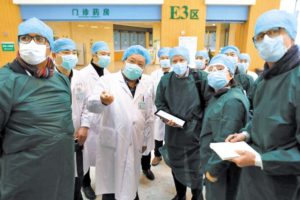

As the coronavirus continues to spread at an alarming rate, affecting 209 countries and killing more than 82,000 people, China has been accused of fooling the world by suppressing information about the virus. Reports have emerged that China tried to bury evidence that could have led to the discovery of the deadly virus and it deliberately did not alert other countries at the right time about the outbreak.
China shamelessly tried to divert attention from the inconvenient truth that for close to two months it covered up the extent and even existence of the virus, in a selfish effort to shield its economy and spare the blushes of the ruling Communist Party.
This criminally negligent behaviour allowed the virus to spread to an unsuspecting world. The Party would be happier if you simply forgot this; instead it should be shouted from the rooftops.
The world today is fighting the deadly novel coronavirus as a biological war with all the resources at their disposal. On many counts China is to blame. It is no coincidence that China has been focusing on biological warfare and integration of biotechnology with information technology in their military doctrine. It has been actively embedding, even sponsoring its people, in academic institutions in the West to gain access to high-end technology.
Initially, the world was appreciative of China’s efforts to control the pandemic so early, but later realised that the virus started from China and it neither made efforts to control the virus nor informed the world about it. Hence, the US president Donald Trump named it as “Wuhan virus” just to emphasise that the virus started from Wuhan, China. U.S. Secretary of State Mike Pompeo also indicated towards China for the outbreak.


Criminal Negligence
The Hong Kong-based South China Morning Post reported that “patient zero” – the first carrier of the coronavirus – was a 55-year-old man from Hubei province, detected as far back as 17 November 2019. However, it was only on December 31, 2019 – by when the virus had already had nearly two months to infect unprotected people – that the Chinese government released initial information on the new virus.
Doctors in Wuhan, and throughout China, were ordered “not to disclose any information about the disease to the public.” It was only after the first case of Coronavirus in Japan on January 15, 2020 raised possibility of human-to-human transmission, and videos of people dropping dead on Wuhan streets went viral, that Chinese authorities admitted to human-to-human transmission of the virus on January 23.
The Chinese government locked down Wuhan on Jan 23, halting all public transportation going in and out of the city. The following day an order was issued suspending group travel within China. But in a blunder that would have far reaching consequences, China did not issue an order suspending group travel to foreign countries until three days later. By then, perhaps, deliberately or unknowingly infected Chinese and foreigners had been sent to all parts of the world.
According to a report published by The New York Times on 22 March, “at least 175,000 people left Wuhan on 1 January 2020. The departures from Wuhan accelerated over the next three weeks. About 7 million people left in January, before travel was restricted.”
China must acknowledge its mistakes and offer to pay compensation for those who have died and bear medical expenses of others. It is in China’s interest to do so, to regain the trust of the international community.


Deliberate Misinformation
Scientists and medical journals warned about the outbreak of the virus. In an article in 2007 and experts in 2019 cautioned about the outbreak of the virus in South China because of eating horseshoe bats and mammals in southern China but government took no action.
When a doctor from the epicentre of the outbreak Wuhan, Li Wenliang, reported the virus for the first time to his medical school classmates in a private WeChat group and later gained traction after screenshots of his messages were shared in many Chinese forums, the authorities arrested him and he later died due to the virus.
Human rights advocate Chen Qiushi tried to warn government and fellow citizens about this dangerous virus and the severity of the situation.
China also expelled American journalists who may have written with facts about Chinese hand in creation and spread of coronavirus. Chinese spokespersons also tried to give the twist of racism and prejudices towards them but forgot that they are one of the worst racists and human right violators.
US President Donald Trump in a media briefing referred to COVID-19 as the “Chinese virus”, which offended China. Following this, the Chinese government and media claimed that the United States was involved in the outbreak of the virus. On March 12, China’s foreign ministry spokesman Zhao Lijan claimed on Twitter that the virus had arrived in China from the United States during the Military World Games in Wuhan in October 2019, alleging that the US Army athletes brought this virus with them.
A British newspaper said scientists had warned UK prime minister Boris Johnson that China could have downplayed its number of confirmed cases of the coronavirus “by a factor of 15 to 40 times.”
Propaganda Fig Leaf
As the novel coronavirus continued its deadly march from Wuhan across the globe, the Chinese attempted to turn the pandemic caused by their own complacency and incompetence, into a propaganda victory by highlighting how effectively China had controlled the disease and China delivering supplies and expertise to the countries it infected.
Suspected Chinese operatives stepped up their efforts offering influential Chinese-speaking Twitter users cash for favorable posts. These efforts appeared to be aimed at disparate audiences outside the country. Most of the posts were in Chinese and aimed at influencing the millions of ethnic Chinese who live outside of China’s borders. Others were in English. The tweets were seen by few people living in China; the Great Firewall blocks Twitter from the Chinese internet, though tech-savvy domestic users find workarounds.
With the epidemic spreading across the world, fake and hijacked accounts sought to promote the Chinese government’s image abroad and shore up its support at home. One typical recent tweet in Chinese proclaimed: “We were not scared during the outbreak because our country was our rearguard. Many disease-fighting warriors were thrust to the front lines. Even more volunteers helped in seemingly trivial yet important ways.”
Chinese Communists believe that appearance of doing good is more important than actually doing it, and so far, media reactions have proved them right. Chinese propaganda machine went into overdrive, praising China for buying time for the world to respond to the pandemic and for leading the global response to the coronavirus. Both claims are false, despite being widely bandied about in the media.
Wuhan’s officials destroyed evidence and harassed medical professionals who warned about the new virus. After president Xi Jinping took charge of China’s response, he lied to World Health Organization officials and waited until after infected people reached Thailand, South Korea, and the United States before initiating lockdowns. For months, China obstructed not the disease, but rather the people trying to stop it.
Blocked UN Security Council Debate
Until 31 March, when the United Nations Security Council (UNSC) was chaired by China, discussion on the coronavirus was blocked. The 15-member UNSC and 193-strong UN General Assembly (UNGA) did not take up the matter under China’s pressure.
The monthly chair of the UNSC decides what is on the agenda and guides the body. China blocked the draft on coronavirus and did not allow the global issue to be discussed. Meanwhile, many countries wanted to pass a proposal on the global issue but China constantly placed obstructions, with involved and knowledgeable persons hitting out online.
Earlier on March 3, China’s UN Ambassador Zhang Jun said there was no need to panic over the coronavirus epidemic and that Beijing did not plan to discuss the situation in the Security Council during its presidency in March.
Estonia, which is a nonpermanent member, had asked for a meeting on the pandemic in mid-March. The document stressed the “growing concern about the unprecedented extent of the Covid-19 outbreak in the world, which may constitute a threat to international peace and security.” The proposal, however, did not go far, with both China and Russia nixing the idea. Calls for virtual UNSC meetings in the era of social distancing and lockdowns have also found no merit with either China or Russia.
While the UN stonewalled a discussion when the G-20 leaders sat down on 26 March for a unique virtual summit, there was no questioning for transparency or origin of the virus.
April will be different. the Dominican Republic has assumed the presidency of the UNSC. Not only is China the source of the pandemic, the US-China rivalry is playing out in the background as well with President Donald Trump insisting on referring to the disease as ‘China virus’.
The UNSC has five permanent members – China, France, the Russian Federation, the United Kingdom, and the United States. The other 10 non-permanent members are Germany, Dominican Republic, Belgium, Estonia, Indonesia, Niger, Saint Vincent and the Grenadines, South Africa, Tunisia and Vietnam.
Pressure on WHO
The World Health Organisation (WHO) avoided mentioning Wuhan and named the ailment as COVID-19. WHO also gave no heed to a letter from Taiwan written in December 2019, in which Taiwan stated that coronavirus spreads from human to human and also requested to adopt precautionary measures. Taiwan took preventive measures and although it is so near to China it saved itself from the disaster.
Chinese authorities denied that the virus could be transferred from human to human – WHO assented to that conclusion, despite the suspicions of other outside health experts – until it was too late and long after doctors in Wuhan had concluded human transmission was ongoing.
The official statement, on 8 January, from the World Health Organization declared, “Preliminary identification of a novel virus in a short period of time is a notable achievement and demonstrates China’s increased capacity to manage new outbreaks….WHO does not recommend any specific measures for travelers. WHO advises against the application of any travel or trade restrictions on China based on the information currently available.”
On 14 January, WHO echoed China’s assessment: “Preliminary investigations conducted by the Chinese authorities have found no clear evidence of human-to-human transmission of the novel coronavirus (2019-nCoV) identified in Wuhan, China.”
On 16 January, WHO updated its statement, declaring, “Not enough is known to draw definitive conclusions about how it is transmitted, the clinical features of the disease, the extent to which it has spread, or its source, which remains unknown.”
WHO director-general Tedros Adhanom Ghebreyesus continued to praise China’s handling of the outbreak. On 22 January he said, “I was very impressed by the detail and depth of China’s presentation. I also appreciate the cooperation of China’s minister of health, who I have spoken with directly during the last few days and weeks. His leadership and the intervention of President Xi and Premier Li have been invaluable, and all the measures they have taken to respond to the outbreak.”
In the preceding days, a WHO delegation conducted a field visit to Wuhan. They concluded, “deployment of the new test kit nationally suggests that human-to-human transmission is taking place in Wuhan.” The delegation reported, “their counterparts agreed close attention should be paid to hand and respiratory hygiene, food safety and avoiding mass gatherings where possible.”
Economic Benefit
Initially, the Chinese economy suffered a huge setback. China’s January-February fixed-asset investment fell 45% year-over-year. Industrial production declined by 14%, and retail sales fell by at least 20%, not counting March.
But end-March, manufacturing data showed the lights had been turned on in China. Manufacturing PMI came in at 52 versus consensus of 44. Non-Manufacturing PMI came in at 52.3 versus consensus estimates of 42. Anything over 50 is positive. PMIs are calculated on a month to month basis. These are March numbers versus February, which saw most of the country’s factories closed because of SARS coronavirus containment efforts.
S&P Global Ratings has maintained its forecast for China’s growth at just under 3%, one of the more bullish calls around.
China will emerge as a big beneficiary because of spread of coronavirus. Shares of European and American companies based in China fell and China, with deep pockets, has purchases shares of these companies.
Large number of old Chinese people died as a result of COVID-19. The government saved a substantial amount of old age pension. China economy is recovering, employees are returning to the factories. Wuhan, the epicentre of the epidemic ended the lockdown, sales picked up, aviation industry was restoring flights, and so on.
==============
China’s Conspiracy Theories
While USA termed the disease as “Chinese Virus”, Beijing-based a Chinese military official blamed USA for having deliberately injected the virus in Wuhan during the international military games from 18 to 27 October 2019, in which 360 American athletes had taken part, but could not win a single medal. He added that five of their athletes had fallen sick but doctors could not detect the cause of their disease. After their treatment and release from hospital, the five athletes were flown back home in a specially chartered US plane.
Eyebrows were raised in China, Russia, Japan, Taiwan and Germany and probing questions asked why they were segregated from other 355 soldier athletes. Suspecting them to be biochemical soldiers, China asked USA to hand over those five to WHO for testing whether they had contracted Type C strain as in the case of all other patients in Wuhan?
This conspiracy theory rested on the premise that, on 6 August 2019, Centre for Disease Control and Prevention issued an order to a major biological warfare lab in Fort Detrick, Maryland to immediately close down and suspend all operations due to its failure to contain contaminated waste, which might have contained agents such as Ebola, Smallpox, Anthrax, SARS.
The Chinese claim that Corona virus was experimented in a British lab – Pirbright Institute – as a biological weapon. After getting registered in USA, the product was transported to a Canadian lab and from there to a lab in Wuhan. Before shipping it, an anti-virus safety exercise was conducted six weeks prior to the outbreak of this epidemic. The same team is now busy manufacturing anti-coronavirus vaccine. Israel has also produced a drug to treat this virus which will be available in markets in next 4-5 months.
















